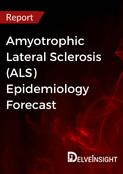Amyotrophic Lateral Sclerosis Epidemiology
Key Highlights
- In the 7MM, the total prevalent cases of ALS was around 67,000 in 2023, which is expected to grow during the study period (2021-2034).
- The United States contributed to the largest diagnosed prevalent population of ALS, acquiring ~40% of the 7MM in 2023.
- Amongst EU4 and the UK, the age group of 70–79 accounted for the highest cases in 2023, followed by 60–69 and 50–59 years.
- The major sites of onset of ALS are the bulbar, and spinal, along with other uncertain regions. In 2023, the patients with the spinal as a site of onset accounted highest cases in the US, i.e., 15,000, followed by the bulbar site of onset.
- In 2023, the patients with the spinal as a site of onset accounted for around 7,000 cases in Japan
DelveInsight’s "Amyotrophic Lateral Sclerosis –Epidemiology Forecast – 2034" report delivers an in-depth understanding of ALS, historical and forecasted epidemiology in the United States, EU4 (Germany, France, Italy, and Spain) and the United Kingdom, and Japan.
Geography Covered
- The United States
- EU4 (Germany, France, Italy, and Spain) and the United Kingdom
- Japan
Study Period: 2021-2034
Amyotrophic Lateral Sclerosis Disease Understanding
Amyotrophic Lateral Sclerosis Overview
ALS, often referred to as Lou Gehrig's disease, is a progressive neurodegenerative disorder affecting the nerve cells in the brain and spinal cord, leading to muscle weakness, paralysis, and ultimately respiratory failure. While the exact cause remains unclear, a combination of genetic and environmental factors likely contributes to its onset. Diagnosis relies on neurological examination and various tests to rule out other conditions.
Amyotrophic Lateral Sclerosis Diagnosis
Diagnosing ALS involves a thorough neurological examination, medical history review, and various tests to exclude other possible conditions. Electromyography (EMG) and nerve conduction studies evaluate nerve and muscle function, while imaging scans like MRI rule out alternative causes of symptoms. Despite these efforts, ALS diagnosis remains challenging without a definitive test. Early and accurate diagnosis is crucial for initiating symptom management and support services. Biomarkers, like cerebrospinal fluid neurofilament levels, though not yet integrated into clinical practice, show promise for diagnosis and monitoring effects. They could aid in patient stratification and research studies, particularly in cases where symptoms are ambiguous or overlap with other conditions.
Further details related to diagnosis are provided in the report…
Amyotrophic Lateral Sclerosis Epidemiology
The ALS epidemiology chapter in the report provides historical as well as forecasted epidemiology segmented by the Total Prevalent Population of ALS, Diagnosed Prevalence of ALS, Type-specific Distribution of ALS, Gender-specific Distribution of ALS, Mutation-specific Distribution of ALS, Distribution Based on Site of Onset of ALS, and Age-specific Distribution of ALS in the 7MM market covering the United States, EU4 (Germany, France, Italy, and Spain) and the United Kingdom, and Japan from 2021 to 2034.
- Among the 7MM, the US accounted for the highest prevalent cases of ALS in 2023, with around 24,000 cases; these cases are expected to increase during the forecast period.
- Amongst EU4 and the UK, the diagnosed prevalent cases of ALS were highest in Germany, while the lowest number of cases was in Spain in 2023.
- The major sites of onset of ALS are the bulbar, and spinal, along with other uncertain regions. In 2023, the patients with the spinal as a site of onset accounted highest cases in the US, i.e., 15,000, followed by the bulbar site of onset.
- According to the estimates, in Japan, it is observed that ALS was most prevalent in the 70-79 years age group, followed by 60-69 years, and 50–59 years.
Scope of the Report
- The report covers a segment of key events, an executive summary, descriptive overview of ALS, explaining its causes, signs and symptoms, and pathogenesis.
- Comprehensive insight into the epidemiology segments and forecasts, and disease progression has been provided.
- The report provides an edge while developing business strategies, understanding trends, expert insights/KOL views, and patient journey in the 7MM.
- A detailed review of current challenges in establishing the diagnosis.
Amyotrophic Lateral Sclerosis Report Insights
- Patient Population
- Country-wise Epidemiology Distribution
- Age-wise cases of Amyotrophic Lateral Sclerosis
Amyotrophic Lateral Sclerosis Report Key Strengths
- Eleven Years Forecast
- The 7MM Coverage
- Amyotrophic Lateral Sclerosis Epidemiology Segmentation
Amyotrophic Lateral Sclerosis Report Assessment
- Current Diagnostic Practices
Epidemiology Insights
- What are the disease risk, burdens, and unmet needs of Amyotrophic Lateral Sclerosis? What will be the growth opportunities across the 7MM concerning the patient population with Amyotrophic Lateral Sclerosis?
- What is the historical and forecasted Amyotrophic Lateral Sclerosis patient pool in the United States, EU4 (Germany, France, Italy, and Spain) and the United Kingdom, and Japan?
- Which age group of Amyotrophic Lateral Sclerosis has a high patient share?
Reasons to Buy
- Insights on patient burden/disease, evolution in diagnosis, and factors contributing to the change in the epidemiology of the disease during the forecast years.
- To understand the age-specific Amyotrophic Lateral Sclerosis prevalence cases in varying geographies over the coming years.
- To understand the perspective of key opinion leaders around the current challenges with establishing the diagnosis.
- Detailed insights on various factors hampering disease diagnosis and other existing diagnostic challenges.

